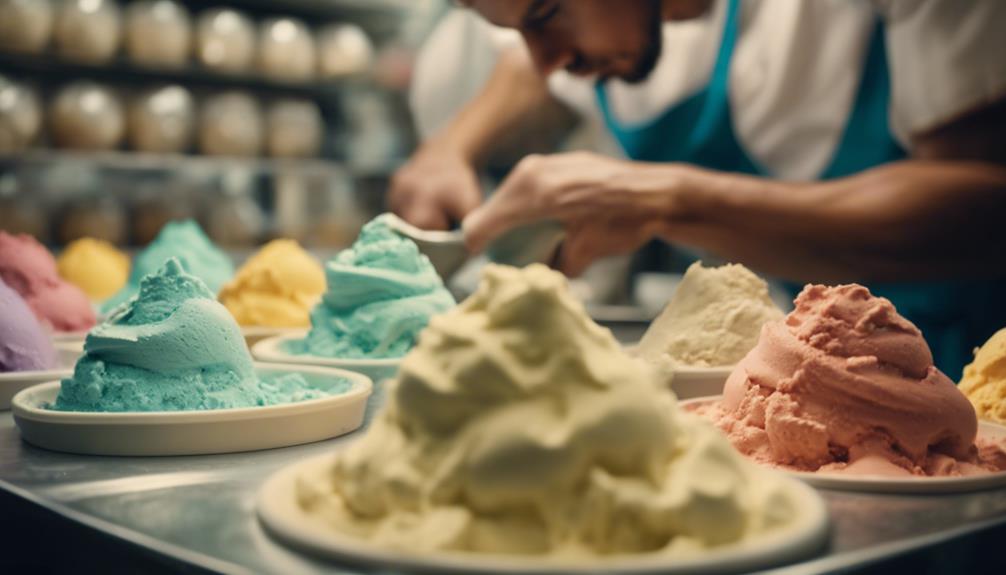Yes, gelato can be gluten-free, but you need to be cautious. Basic ingredients like milk and sugar are safe, and classic flavors such as vanilla and chocolate typically don’t contain gluten. However, be cautious of flavors that include cookies or cake, as these usually contain gluten. Cross-contamination is another risk, especially in shops that use shared equipment. Always ask questions and check labels. Opt for cups instead of cones to minimize exposure. If you’re curious about specific gluten-free options and precautions, there’s more valuable information waiting for you.
Key Takeaways
- Most basic gelato ingredients like milk, sugar, and egg yolks are gluten-free, making classic flavors generally safe.
- Flavors containing cookies, cakes, or certain additives may include gluten, so always check ingredient lists.
- Cross-contamination is a risk in gelato shops; confirm staff use separate scoops for gluten-free options.
- Opt for cups instead of cones to avoid gluten exposure, as cones typically contain gluten.
Understanding Gluten in Gelato
When it comes to gelato, you'll find that its basic ingredients—milk, sugar, and egg yolks—are naturally gluten-free. This means that gelato is typically gluten-free, making it a delicious treat for those avoiding gluten.
However, not all gelato is created equal. While classic flavors like vanilla, chocolate, and many fruit-based sorbets are safe, some varieties may contain gluten. Flavors that include cookies, cakes, or certain flavorings can introduce gluten into the mix. For instance, cookies & cream, tiramisu, and cheesecake can contain gluten-filled mix-ins. So, if you're craving something beyond the classic options, it's vital to be mindful of what you're choosing.
Always check labels and ingredient lists, especially for commercial gelato brands. Some stabilizers or emulsifiers might vary and could potentially include gluten.
Additionally, if you're at a gelato shop, don't hesitate to ask about their gluten-free options and how they manage the risk of cross-contamination. Being informed and cautious will guarantee you enjoy your gelato without concern, keeping your sweet experience safe and satisfying.
Cross-Contamination Risks

When you order gelato, be aware of shared equipment that can lead to cross-contamination.
It's important to communicate your dietary restrictions to the staff, ensuring they take the necessary precautions.
Shared Equipment Concerns
Shared equipment in gelaterias poses a significant cross-contamination risk for those with gluten sensitivities, as scoops and utensils can transfer gluten from one flavor to another.
Even if you choose gluten-free flavors, the use of shared scoops can lead to accidental contamination. It's crucial to be aware of these risks, especially in busy environments where staff may not always use a clean scoop for each flavor.
Consider the following points when enjoying gelato:
- Ask about tools: Confirm that staff use separate, clean scoops for gluten-free options.
- Avoid cones: Waffle and plain cones typically contain gluten, so choose a cup to minimize risk.
Communicating Dietary Restrictions
To enjoy gelato safely, it's important to clearly communicate your dietary restrictions to the staff, especially regarding gluten-free options. This helps minimize the risk of cross-contamination, which can occur when shared scoops or utensils are used.
Here are some tips for effective communication:
| Tip | Description | Why It Matters |
|---|---|---|
| Ask Specific Questions | Inquire about gluten-free flavors and preparation methods | Guarantees gelato staff understand your needs |
| Request Clean Utensils | Ask for dedicated scoops or utensils for your gelato | Reduces the risk of cross-contact |
| Opt for a Cup, Not a Cone | Choose a cup to avoid gluten from cones | Minimizes exposure to gluten residue |
Be proactive in confirming that the gelato staff are aware of your gluten sensitivities. Busy environments can lead to mistakes, so asking these questions is essential. If you're traveling, learn useful phrases in the local language to effectively communicate your gluten-free needs. Remember, your health is a priority!
Gluten-Free Gelato Brands

Several brands, like Grom, Talenti, Ciao Bella, and Gelato Fiasco, offer delicious gluten-free gelato options that cater to your dietary needs. When you're looking for a tasty treat, it's crucial to know that gelato is gluten-free in many cases. These gluten-free gelato brands take special care to guarantee your gelato is safe and delicious.
Here are some highlights from these brands:
- Grom: This brand not only offers gluten-free cones but also a selection of flavors that contain no gluten, perfect for your cravings.
- Talenti: With a clear labeling system, Talenti highlights gluten-free flavors, so you can easily spot what's safe to eat.
When you visit gelaterias, don't hesitate to ask if they use gluten-free ingredients. Always remember to order gluten-free gelato to enjoy a worry-free dessert experience. With these brands, you can indulge without compromising your health!
Homemade Gelato Safety

Making gelato at home can be a fun and rewarding experience, but it's important to guarantee your ingredients are gluten-free to keep your treat safe and enjoyable. To confirm homemade gelato safety, carefully read labels on all ingredients, including flavorings and stabilizers, since gelato is gluten in many commercial varieties. If you're part of the gluten-free community, you'll want to avoid any accidental gluten exposure.
To prevent cross-contamination, use separate utensils and equipment dedicated solely to gluten-free cooking. Regularly clean your surfaces and equipment to eliminate any potential gluten residue from previous cooking sessions. When selecting recipes, opt for gluten-free options like fruit-based sorbets or classic vanilla flavors.
Familiarizing yourself with gluten-containing ingredients is essential. Take the time to educate yourself on what to look for, so you can confidently find gluten in any mix-ins or flavoring agents you may consider for your gelato.
Navigating Gelato Flavors

When you're choosing gelato, it's important to know which flavors are safe and which ones might pose a risk for gluten sensitivity.
Classic options like vanilla, chocolate, and fruit sorbets are usually gluten-free, while others like cookies & cream and tiramisu can contain gluten-rich ingredients.
Always check ingredient labels or ask the gelato maker to confirm you're making a safe choice.
Safe Gelato Flavors
You can enjoy a variety of safe gelato flavors that are naturally gluten-free, like classic vanilla, rich chocolate, and nutty pistachio. These popular gelato flavors typically use simple ingredients such as milk, sugar, and egg yolks, making them a delicious option for those avoiding gluten.
Here are some other safe gelato options to bear in mind:
- Fruit-based sorbets like lemon and strawberry
- Nut flavors such as hazelnut or almond
When you're at a gelateria, always double-check the ingredients for any hidden sources of gluten, especially in flavors that might contain mix-ins.
Additionally, it's essential to ask about cross-contamination, as some shops may use the same scoops or utensils for different flavors.
Brands like Venchi, Grom, and Talenti often provide gluten-free labels, giving you peace of mind while indulging in your favorite treat.
Enjoying gelato can be a worry-free experience when you stick to these safe flavors and stay informed about the ingredients used.
Risky Gelato Flavors
Certain gelato flavors, like cookies & cream and tiramisu, frequently hide gluten-rich ingredients that can pose a risk for those with sensitivities. You need to know that flavors such as cheesecake and brownie gelato are also high-risk due to their inclusion of cookies or cake. These ingredients often contain gluten, making them unsafe for anyone with gluten intolerance.
Even traditional Italian gelato flavors like stracciatella and zuppa inglese may contain gluten, so it's important to check the ingredients carefully. When you're ordering gelato, always ask about the specific ingredients used in each flavor to avoid any gluten exposure.
On the bright side, many popular gelato flavors, including vanilla and chocolate, are typically gluten-free, providing safer options for you. If you're looking for the best choices, fruit-based sorbets are naturally gluten-free and usually made without any gluten-containing additives.
Communicating Dietary Restrictions

Clearly communicating your gluten-free needs to gelato staff is essential for a safe and enjoyable experience. To guarantee you get the right flavors without worrying about cross-contamination, here are some tips to keep in mind:
- Use phrases like 'Non posso mangiare glutine' to clearly state your dietary restrictions.
- Ask about gluten-free options, including flavors and whether separate scoops and tools are used to prevent cross-contamination.
Always check the ingredients in toppings, such as sprinkles or sauces, to confirm they're gluten-free.
Educating yourself about common gluten-containing ingredients can greatly enhance your discussions with staff and help you make informed choices.
Remember, clarity is key! By clearly expressing your needs and asking the right questions, you can enjoy gelato without worrying about gluten exposure.
Whether you're indulging in a classic flavor or trying something new, effective communication will make your experience much more enjoyable.
Resources for Gluten-Free Living

Finding reliable resources can make gluten-free living much easier and more enjoyable. Whether you're managing celiac disease or simply avoiding eating gluten, having the right tools at your disposal is essential. Here's a quick overview of some valuable resources you can tap into:
| Resource Type | Description |
|---|---|
| Apps | Use the 'Find Me Gluten Free' app to discover gluten-free restaurant options and read user reviews. |
| Online Communities | Join forums where members share experiences, tips, and support for steering through a gluten-free diet. |
| Travel Resources | Check out Celiac Travel for gluten-free restaurant cards to communicate your dietary needs while traveling. |
Additionally, educational websites often provide extensive lists of ingredients to help you make safe choices. Blogs like 'Gluten-Free Globetrotter' offer insights for gluten-free travelers seeking safe dining experiences, including gelato options. By leveraging these resources, you can confidently explore gluten-free living without the constant worry about what you're eating.
Frequently Asked Questions
Can Celiacs Eat Gelato?
Yes, celiacs can eat gelato, but you need to be cautious. Stick to naturally gluten-free flavors, avoid high-risk options, and always ask about cross-contamination to guarantee your safety while enjoying this delicious treat.
Does Talenti Gelato Have Gluten in It?
When diving into Talenti's delightful flavors, you'll find some do contain gluten. Always check the ingredients and allergen info; it's your best bet to avoid any gluten surprises in your sweet treat.
What Types of Ice Cream Is Not Gluten Free?
Certain ice cream flavors aren't gluten-free, especially those with cookie or cake pieces, like cookies & cream and brownie. Always check labels and ask about cross-contamination to verify your treat is safe for you.
Does Gelato Have Dairy or Gluten?
Gelato typically contains dairy, as it's primarily made from milk and sugar. While most flavors are gluten-free, some may have gluten due to added ingredients, so always check labels and ask staff about specific flavors.
Conclusion
In the world of gelato, steering through gluten-free options can feel like finding a needle in a haystack.
But just like that perfect scoop of creamy goodness, with a little patience and knowledge, you can enjoy your treat worry-free.
Remember, many gelato shops offer gluten-free flavors, and by communicating your dietary needs, you're ensuring a safe and delicious experience.
So, embrace the journey and savor every bite—life's too short for bland desserts!









